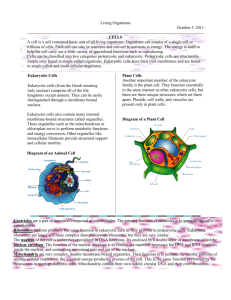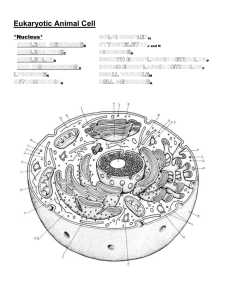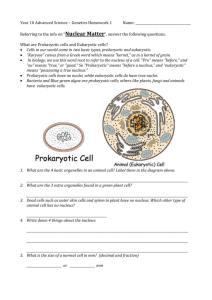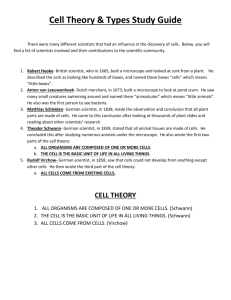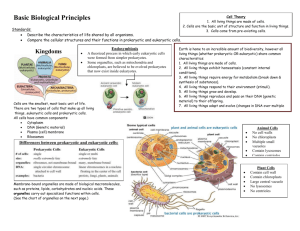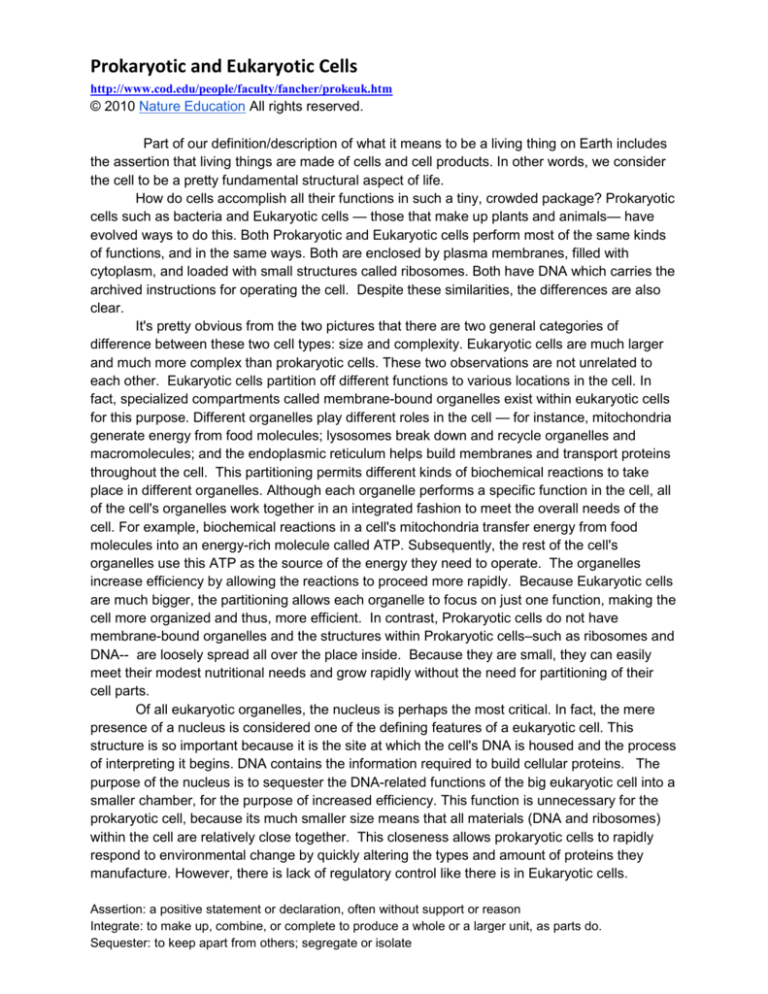
Prokaryotic and Eukaryotic Cells
http://www.cod.edu/people/faculty/fancher/prokeuk.htm
© 2010 Nature Education All rights reserved.
Part of our definition/description of what it means to be a living thing on Earth includes
the assertion that living things are made of cells and cell products. In other words, we consider
the cell to be a pretty fundamental structural aspect of life.
How do cells accomplish all their functions in such a tiny, crowded package? Prokaryotic
cells such as bacteria and Eukaryotic cells — those that make up plants and animals— have
evolved ways to do this. Both Prokaryotic and Eukaryotic cells perform most of the same kinds
of functions, and in the same ways. Both are enclosed by plasma membranes, filled with
cytoplasm, and loaded with small structures called ribosomes. Both have DNA which carries the
archived instructions for operating the cell. Despite these similarities, the differences are also
clear.
It's pretty obvious from the two pictures that there are two general categories of
difference between these two cell types: size and complexity. Eukaryotic cells are much larger
and much more complex than prokaryotic cells. These two observations are not unrelated to
each other. Eukaryotic cells partition off different functions to various locations in the cell. In
fact, specialized compartments called membrane-bound organelles exist within eukaryotic cells
for this purpose. Different organelles play different roles in the cell — for instance, mitochondria
generate energy from food molecules; lysosomes break down and recycle organelles and
macromolecules; and the endoplasmic reticulum helps build membranes and transport proteins
throughout the cell. This partitioning permits different kinds of biochemical reactions to take
place in different organelles. Although each organelle performs a specific function in the cell, all
of the cell's organelles work together in an integrated fashion to meet the overall needs of the
cell. For example, biochemical reactions in a cell's mitochondria transfer energy from food
molecules into an energy-rich molecule called ATP. Subsequently, the rest of the cell's
organelles use this ATP as the source of the energy they need to operate. The organelles
increase efficiency by allowing the reactions to proceed more rapidly. Because Eukaryotic cells
are much bigger, the partitioning allows each organelle to focus on just one function, making the
cell more organized and thus, more efficient. In contrast, Prokaryotic cells do not have
membrane-bound organelles and the structures within Prokaryotic cells–such as ribosomes and
DNA-- are loosely spread all over the place inside. Because they are small, they can easily
meet their modest nutritional needs and grow rapidly without the need for partitioning of their
cell parts.
Of all eukaryotic organelles, the nucleus is perhaps the most critical. In fact, the mere
presence of a nucleus is considered one of the defining features of a eukaryotic cell. This
structure is so important because it is the site at which the cell's DNA is housed and the process
of interpreting it begins. DNA contains the information required to build cellular proteins. The
purpose of the nucleus is to sequester the DNA-related functions of the big eukaryotic cell into a
smaller chamber, for the purpose of increased efficiency. This function is unnecessary for the
prokaryotic cell, because its much smaller size means that all materials (DNA and ribosomes)
within the cell are relatively close together. This closeness allows prokaryotic cells to rapidly
respond to environmental change by quickly altering the types and amount of proteins they
manufacture. However, there is lack of regulatory control like there is in Eukaryotic cells.
Assertion: a positive statement or declaration, often without support or reason
Integrate: to make up, combine, or complete to produce a whole or a larger unit, as parts do.
Sequester: to keep apart from others; segregate or isolate
Level 3
Complete Summary Template
Level 4
Guided Questions
1. What is a cell?
2. In what ways are Prokaryotic and Eukaryotic cells similar?
3. How are Prokaryotic and Eukaryotic cells different?
4. Because of their large size, Eukaryotic cells partition off different functions, producing
cell parts called __________. In what ways do organelles help Eukaryotic cells?
5. As an example, why is it necessary to isolate the DNA in a nucleus for the large
Eukaryotic cell but unnecessary to do so in a Prokaryotic cell?
Level 5
6. Between a baseball stadium and an office building, which is more similar to
Prokaryotic cell and which is more similar to a Eukaryotic cell? Explain your answer,
citing from the article.




